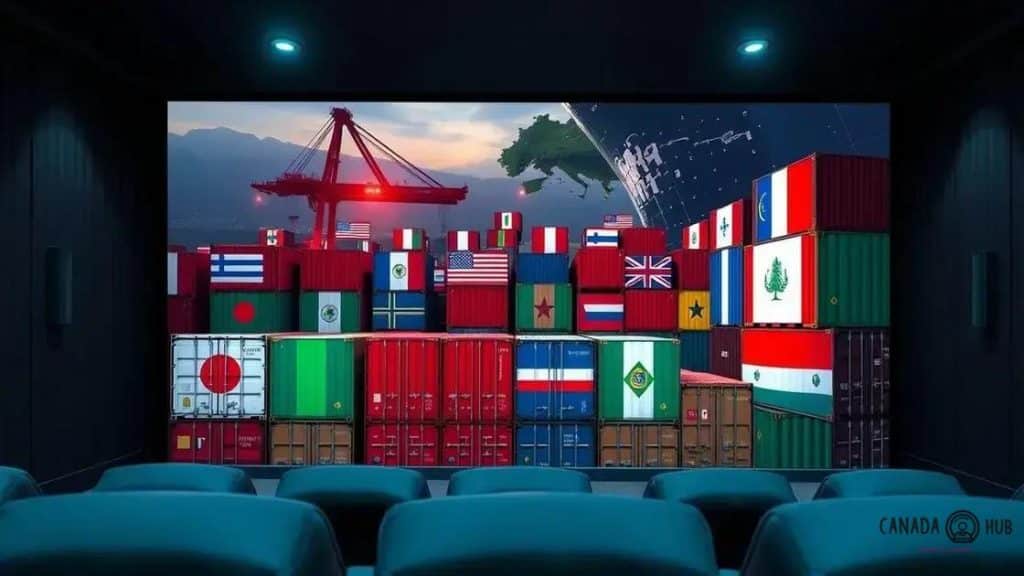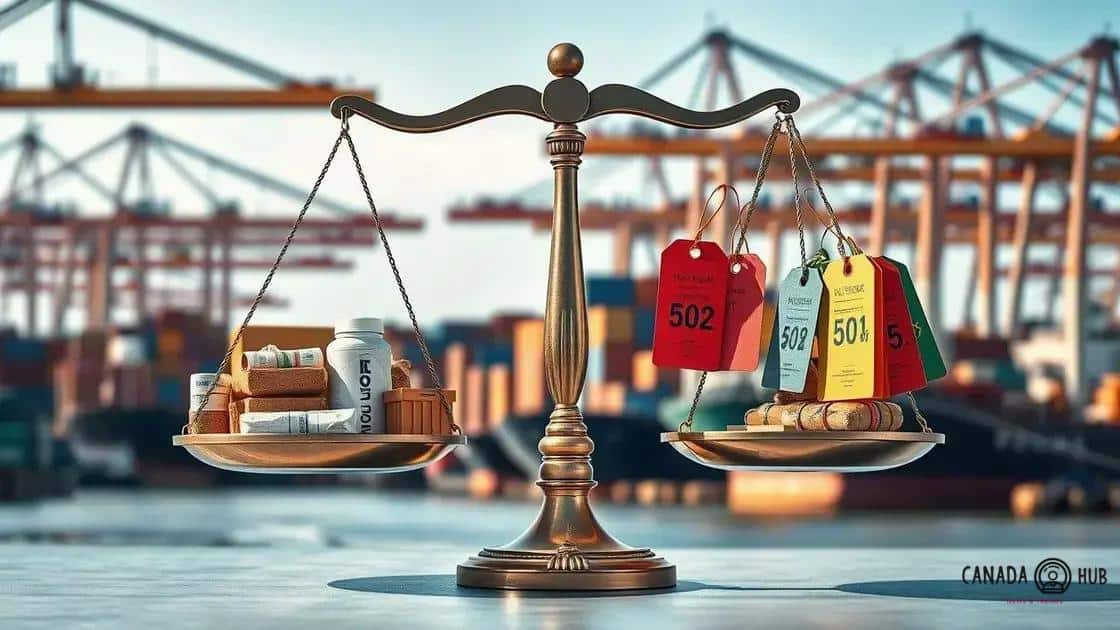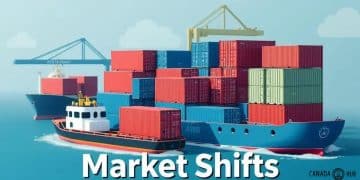Impact of international trade agreements on inflation rates

The impact of international trade agreements on inflation rates includes lower consumer prices through increased competition, but can also create challenges for local industries facing foreign imports.
Impact of international trade agreements on inflation rates is a complex topic that influences economies worldwide. Have you ever wondered how these agreements shape prices and purchasing power? In this article, we’ll delve into these dynamics and their implications.
Understanding international trade agreements
Understanding international trade agreements is crucial in today’s global economy. These agreements affect how countries trade goods and services, impacting economies at various levels. They can shape prices and influence inflation rates worldwide.
What Are International Trade Agreements?
International trade agreements are pacts between countries that determine the rules of trade. They aim to reduce tariffs, quotas, and reduce trade barriers, making it easier and cheaper to trade. Understanding these agreements is essential because they not only facilitate trade but also affect consumer prices.
Types of Trade Agreements
- Free Trade Agreements (FTAs): These agreements eliminate tariffs on goods.
- Customs Unions: These require members to have a common external tariff.
- Trade Agreements with Services: These focus on trade in services, such as banking and insurance.
- Regional Trade Agreements: These are agreements between countries in a specific region.
Each type of agreement has unique implications for inflation. For instance, FTAs can lead to lower prices for consumers as competition increases. When tariffs are reduced, businesses can source cheaper materials, which can keep costs down.
Another point to consider is how these agreements can affect domestic industries. Some local businesses may struggle to compete against foreign imports, impacting their prices. This competitive landscape influences overall inflation rates.
Impact on Economic Policies
Trade agreements can also shape a nation’s economic policy. Countries often adjust their monetary and fiscal policies in response to trade dynamics. For example, if a trade agreement increases imports significantly, a country may consider adjusting interest rates to control inflation.
Moreover, international agreements can lead to economic growth or contraction, influencing inflation in complex ways. When economies grow due to successful trade, prices might stabilize. Conversely, economic decline can lead to higher inflation as demand drops.
In conclusion, understanding international trade agreements provides insight into their role in shaping inflation rates. These agreements have far-reaching effects on prices, competition, and economic policies, making them essential for comprehending the global economic landscape.
The relationship between trade and inflation

The relationship between trade and inflation is complex and significant. Understanding this link can help economies navigate their policies effectively. When countries engage in trade, it influences their inflation rates in various ways.
How Trade Influences Inflation
Firstly, trade can affect supply and demand, which directly impacts prices. For example, when a country imports goods, it increases availability in the market. This can lead to lower prices for consumers, which may help reduce inflation. Conversely, if a country relies heavily on imports and experiences supply chain disruptions, prices can spike, increasing inflation.
Competitive Pressures
- Increased competition from imports can lower prices.
- Local businesses may have to decrease prices to compete.
- Lower prices can lead to lower inflation rates.
- Consumer choices increase with more international products.
Additionally, trade agreements can promote higher levels of competition. When businesses face competition from foreign companies, they are often forced to keep prices low. This helps control inflation. However, it’s essential to balance this with the potential impact on domestic industries.
Trade can also create inflationary pressures. If demand for a country’s exports rises, it can lead to higher prices domestically. For instance, when other nations buy more goods, domestic producers may increase prices, possibly leading to inflation. Understanding these dynamics is crucial for policymakers aiming to manage inflation effectively.
Currency Fluctuations
The value of a country’s currency plays a vital role in the trade-inflation relationship. A stronger currency makes imports cheaper, which can help keep inflation in check. However, if a currency weakens, imports become more expensive, driving prices up and potentially increasing inflation.
Ultimately, the interplay between trade and inflation is significant. Policymakers must monitor trade conditions and inflation rates closely, adapting their strategies to foster a stable economic environment.
Effects on domestic prices and competition
The effects on domestic prices and competition due to international trade agreements are significant and multifaceted. These agreements often lead to increased competition, which plays a crucial role in shaping market dynamics.
Impact on Domestic Prices
When a country opens its markets through trade agreements, it typically experiences an influx of goods from abroad. This can lead to a decrease in domestic prices as consumers have more options available. With more competition, local businesses may need to reduce their prices to attract customers. As prices drop, consumers benefit from lower costs on many goods.
Increased Competition
- Domestic firms may face pressure to innovate and improve quality.
- Competition can lead to better customer service.
- Consumers enjoy a wider variety of products at competitive prices.
- Local industries must adapt to survive in the new market landscape.
As competition increases, companies must focus on efficiencies. They can do this by cutting costs or improving product quality to remain competitive. This process can enhance innovation within domestic industries, leading to improved products and services for consumers.
However, not all impacts are positive. Some local businesses may struggle to compete with foreign imports, leading to potential job losses. When cheaper imported goods flood the market, some companies may need to downsize or close. This can affect not just the businesses but also the workers employed by them.
On the flip side, when domestic firms succeed in competing on an international stage, it can lead to growth and expansion. Successful businesses often create jobs and contribute positively to the economy, further influencing domestic prices.
Ultimately, the effects on domestic prices and competition are a vital part of understanding how international trade agreements shape local economies. By carefully analyzing these dynamics, policymakers can better predict outcomes and create strategies that support both consumers and businesses.
Case studies of specific trade agreements

Analyzing case studies of specific trade agreements provides valuable insights into their real-world effects on economies. These examples illustrate how various agreements impact inflation, economic growth, and consumer behavior.
North American Free Trade Agreement (NAFTA)
The North American Free Trade Agreement, established in 1994, created a trilateral trade bloc between the United States, Canada, and Mexico. This agreement aimed to eliminate tariffs and increase trade. One major effect of NAFTA was the boost in trade volume between these countries. As a result, both consumers and businesses benefited from a greater variety of goods at lower prices.
European Union’s Common Market
The European Union (EU) has implemented numerous trade agreements through its Common Market. These agreements facilitate free movement of goods, services, capital, and labor among member states. The Common Market has led to lower prices and increased competition in the region, significantly impacting inflation rates in various EU countries. For example, countries like Germany and France have seen their economies grow due to increased exports and a competitive market.
Trans-Pacific Partnership (TPP)
The Trans-Pacific Partnership was a proposed trade agreement involving several Pacific Rim countries. Although the U.S. withdrew from it in 2017, the remaining countries moved forward with the Comprehensive and Progressive Agreement for Trans-Pacific Partnership (CPTPP). This agreement aimed to reduce trade barriers and foster economic integration. While the CPTPP is still being evaluated, it is expected to significantly influence member economies, enhancing trade and potentially managing inflation.
China’s accession to the World Trade Organization (WTO)
China joined the WTO in 2001, which altered global trade dynamics. This accession led to increased trade between China and other member countries, resulting in lower prices for many consumer goods. However, it also raised concerns about job losses in some industries. The impact of this trade agreement has been profound, influencing inflation rates globally as consumers gained access to cheaper imported products.
Examining these case studies reveals that while trade agreements can reduce prices and increase competition, they also have significant implications for domestic industries. Assessing their outcomes helps policymakers make informed decisions about future trade agreements.
Future trends in international trade and inflation
Exploring future trends in international trade and inflation offers insights into how global economies may evolve. As economies become more interconnected, understanding these trends becomes essential for businesses and policymakers.
Technological Advancements
One significant trend is the impact of technology on trade. Innovations in logistics, such as automation and blockchain, can streamline supply chains. Improved technology can reduce costs and increase efficiency, leading to lower prices for consumers. When goods are cheaper, inflation rates may stabilize, benefiting the overall economy.
Changing Trade Policies
Another trend involves shifting trade policies. Countries may adopt new strategies in response to global events, such as pandemics or geopolitical tensions. These policies can influence tariffs and trade barriers, affecting prices. For instance, if a country imposes higher tariffs, it may lead to increased prices for imported goods, potentially driving inflation.
- Countries may form new trade partnerships to enhance economic resilience.
- Regulations regarding sustainability are likely to rise, impacting production costs.
- Shifts in consumer preferences can dictate demand for specific goods.
- Emerging markets are expected to play a more significant role in global trade.
Additionally, shifts in consumer preferences, especially towards sustainable products, can drive changes in trade patterns. Industries may need to adapt to meet new demands, which could influence production costs and prices. As countries strive to become more eco-friendly, businesses may face increased costs, leading to inflationary pressures.
Impact of Global Events
Global events, such as economic recessions, will also shape future trade relationships. Economic downturns can lead to reduced trade volumes, significantly impacting prices. When demand decreases, businesses may lower prices to attract customers, which can mitigate inflation. Conversely, recovery from a recession may lead to increased demand and subsequently higher prices.
In conclusion, understanding these future trends in international trade and inflation is key for anticipating economic shifts. Technology, changing policies, consumer preferences, and global events will continue to influence how trade impacts inflation in the coming years.
In summary, international trade agreements have profound impacts on inflation and domestic economies. They can lead to lower prices for consumers through increased competition and access to a wider variety of goods. However, these agreements can also create challenges for local industries facing foreign competition. As we look to the future, technological advancements, shifting trade policies, and global events will continue to shape this landscape. Understanding these dynamics is crucial for policymakers and businesses to adapt effectively and maximize the benefits of trade while managing inflation.
FAQ – Frequently Asked Questions about International Trade Agreements and Inflation
How do international trade agreements affect domestic prices?
International trade agreements generally lead to lower prices for consumers by increasing competition and access to a wider variety of goods.
Can local businesses benefit from trade agreements?
Yes, successful local businesses can expand their markets and grow by competing internationally, which can drive innovation and improvement.
What role does technology play in future trade trends?
Technological advancements improve logistics and efficiency in trade, potentially reducing costs and stabilizing inflation rates for consumers.
How do global events influence trade and inflation?
Global events, such as economic downturns or geopolitical tensions, can alter trade volumes and policies, influencing domestic prices and inflation.





